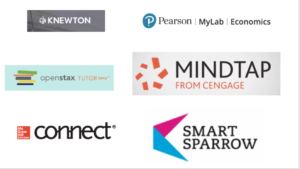 Open source textbooks are OER that are complete texts for a course. Generally, these are digital texts. Many digital texts can be obtained in print form for a modest fee. The print versions should be considered affordable course content, rather than OER/OA.
Open source textbooks are OER that are complete texts for a course. Generally, these are digital texts. Many digital texts can be obtained in print form for a modest fee. The print versions should be considered affordable course content, rather than OER/OA.
Digital texts can be printed by some college bookstores, and by Federal Express or other copy centers. In some cases, print versions of open source textbooks can be purchased from Amazon (e.g. OpenStax books). A recent court ruling found that such printing does not violate CC-NC licensing.
Courseware is digital ancillary materials to support a text, usually bundled with an electronic version of the text. These ancillary materials can include quizzes and homework problems, clicker software, and adaptive or personalized feedback to the student and instructor.
Increasingly, traditional publishers are moving away from print texts to courseware. Courseware, because it includes other features than text, usually has a cost. Traditional publishers charge prices which are cheaper than printed texts, but still not necessarily cheap (e.g. $100). There are commercial businesses that provide ancillary services to OER publishers. Often, these are bundled with an electronic version of text and offered at a lower cost than the courseware offered by traditional publishers (e.g. $25-$50). Lower priced courseware is considered affordable course materials.
[ next question: How does one find OA/OER Course Materials for one’s courses? ]
Recent Comments